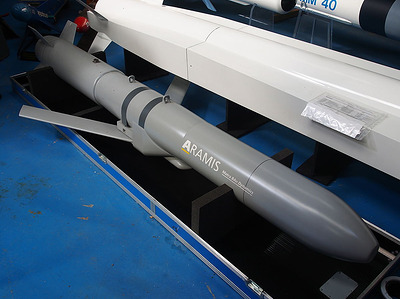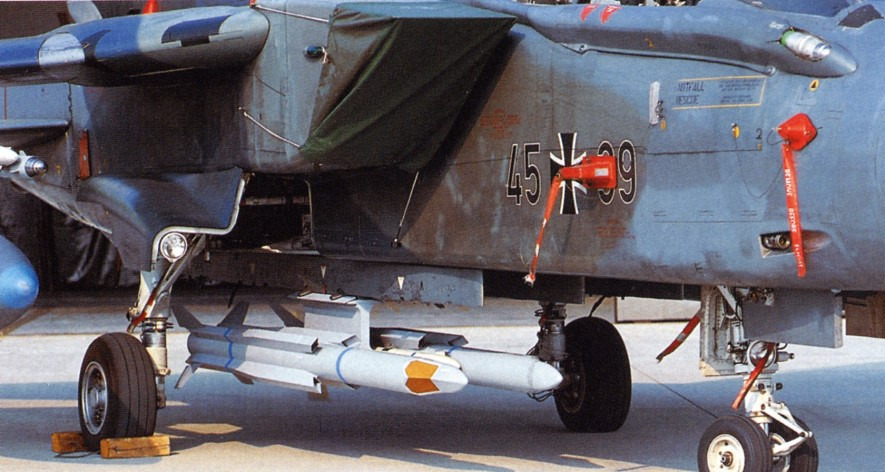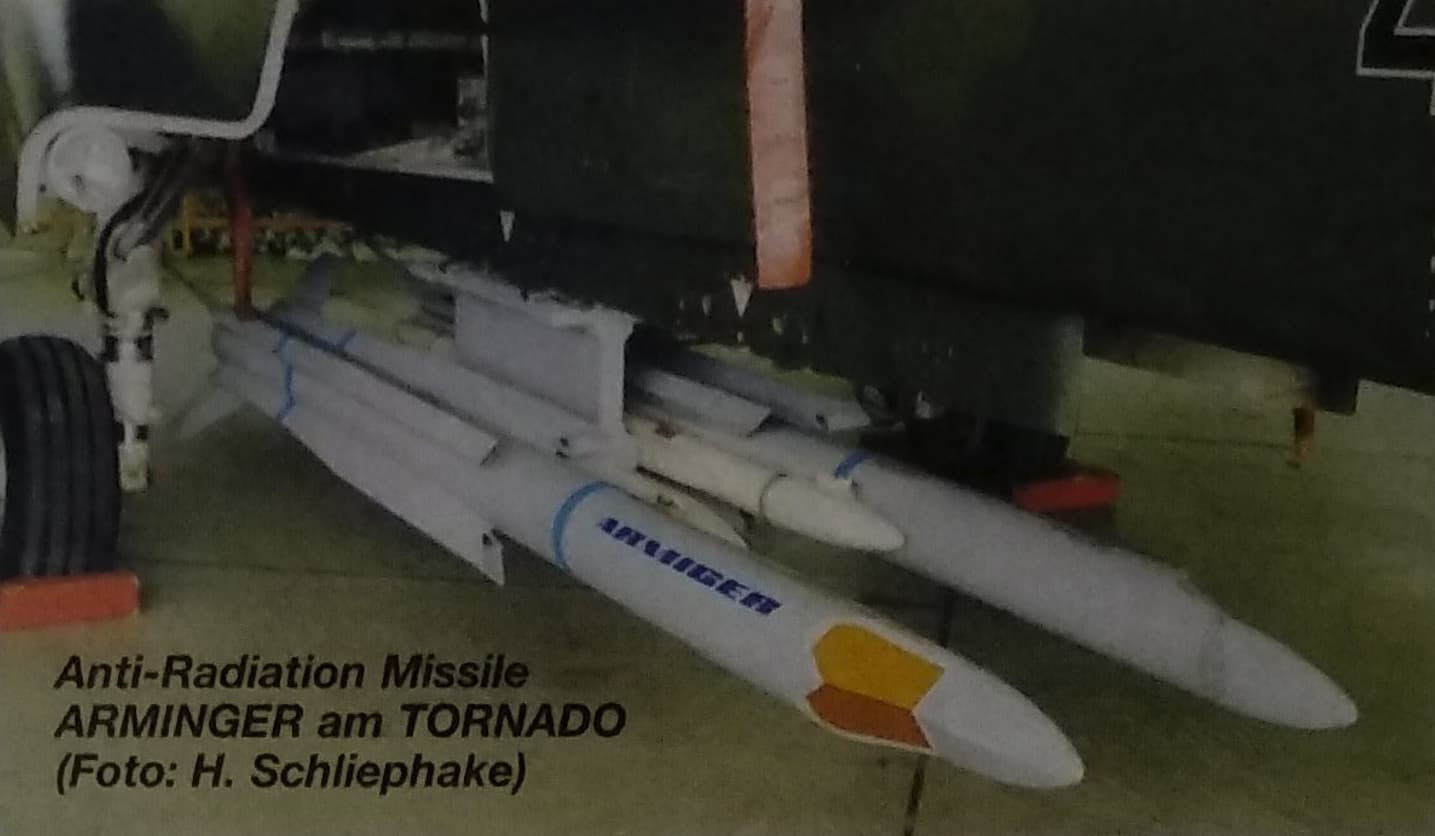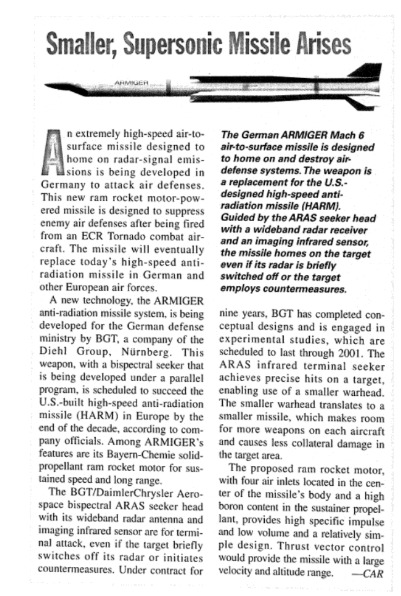
History and introduction
In the 1990s, with the popularisation of radar-dependent missile defence systems and SEAD operations, the then-in-service weapons by NATO, such as the AGM-88 HARM, were increasingly looked upon as lacking.
So, Germany and France teamed up to develop the next generation of SEAD/DEAD weapons. Initial development reached a significant phase with both countries developing at least the design a some technology for an anti-radiation (perhaps rocket boosted) glide bomb called the ARAMIS.
However, as if written in stone, France dropped out in 1996, and Germany set sail to continue the effort alone. The missile was renamed ARMIGER (for “Anti Radiation Missile with Intelligent Guidance & Extended Range”). However, it would be unfair to say that it was renamed, as more or less the entire design was changed from the ground up.
Led by Diehl BGT, the new missile was to be an advanced high supersonic SEAD weapon with an extremely high PoK and extended range that would ensure target destruction while keeping the launching aircraft at a safe range. Unlike the HARM (during the 1990s), the ARMIGER was designed to ensure target destruction even if the emitting radar was switched off. This was accomplished by utilising GPS and INS systems in the missile guidance logic. Upon reaching target co-ordinates the ARAS Bispectral seeker would activate its Imaging Infrared seeker and guide itself into the target with a CEP of less than 1m.

In case of a lack of radar emissions, the IIR seeker can also work by itself and in tandem with GPS guidance. The extreme precision of ARMIGER makes it unnecessary for it to have a large warhead like the HARM. Hence, considering the supersonic speed of impact means a 20KG warhead was deemed enough.
Developing upon the supersonic velocity aspect of ARMIGER, the missile was propelled by a conventional solid-fuel rocket motor in its boost phase, reaching a minimum speed of Mach 3 and a boost-only driven range of 30km from low altitude and 80km from high altitude. Upon reaching Mach 3, the cruise engine would achieve starting conditions.
The Bayern Chemie-developed quad-intake air-breathing Ramjet engine would propel the ARMIGER at a constant velocity of Mach 3 all the way into the target, with a range of 150 to 200km.
The ARMIGER’s dimensions and weight allow the Tornado to carry 4 of them under its fuselage pylons alone, leaving the wet hardpoints on the wings to carry drop tanks, which may be necessary for longer range SEAD missions.
In 1997, Germany attempted to internationalise the ARMIGER program, but no partnership was achieved. BGT conducted engine and seeker tests separately in 1997 and 1998. In July 1999, BGT was awarded a contract to advance development to the point of demonstration flights. Initial free-flight tests were planned for 2003 but were conducted ahead of schedule in December 2001 from a ground-based launcher. Later, the missile underwent compatibility trials on a Tornado IDS as well.
Compatible aircraft:
- GAF Tornado IDS (trialled)
- Tornado ECR (made for it)
Technical Specifications
Missile characteristics
Mass: 225kg
Length: 4m
Diameter: 20cm
Launch range: 100-150km
Max speed: Mach 4 in boost phase (signal alone claims Mach 6, hence disregardable)
Cruising speed: 3M
Engine: Ramjet with variable thrust as cruising engine
Maximum overload: 35-40G
Warhead mass: 20kg
CEP: >=1
Visual References



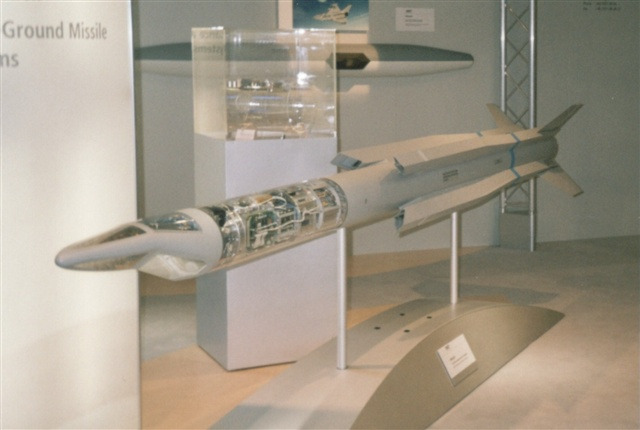
Promoted meme
(not IRIST but still phunni)
Sources
Books
Detecting and Classifying Low Probability of Intercept Radar (Philip E. Pace) (pg 600)
TLDR:
Germany is developing the ARMIGER as a HARM replacement: roughly the same weight as the HARM but with improved range, a GPS/IMU (like the AGM-88D upgrade) and a passive-radar / high-resolution IR dual-mode seeker (ARAS) to handle emitter shutdowns.
The GPS/IMU lets the missile fly to pre-planned points when emitters go silent, and combined GPS fixes from multiple aircraft can pre-locate enemy radars before launch.
The U.S. Navy dropped the upgrade, while the Luftwaffe is proceeding cautiously with ARMIGER amid concerns about single-purpose weapons.
Janes Air launched weapons issue 41 (pg 111-112)
TLDR:
ARMIGER is a German BGT-developed anti-radiation missile (evolved from ARAMIS/SPRINT) with a Chemie rocket + ramjet giving cruise speeds of M2–M3 and a dual-mode ARAS passive-radar / high-res IR seeker to defeat radar shut-off and countermeasures.
It measures 4.0 m × 20 cm, launch weight 230 kg (Tornado ECR can carry four vs two AGM-88), carries a ~20 kg HE blast-frag warhead, claims ≈1 m CEP and a “maximum range quoted as in excess of … km” (range value not provided).
Navigation is GPS-aided INS with neural-network/fuzzy-logic guidance; engine ground tests and captive-carry trials preceded a July 1999 flight-demo contract, with guided firings planned for 2003 and a proposed (but not agreed) in-service date of 2005.
Janes IDR Vol 34 (2001)
Jane's Electro-optic Systems (2005)
US Military Documents
Ramjet Tactical Missile Propulsion Status
https://apps.dtic.mil/sti/tr/pdf/ADP013518.pdf
TLDR:
In the early 1990s, Germany and France developed the Aramis anti-radiation missile, but France withdrew in 1996, after which Germany continued as Armiger. Germany is now testing the airframe with captive seeker flights and rocket-boosted mock airframes.
Online sources
Airpower.at
Die neuen europäischen Waffensysteme
ARMIGER is an advanced anti-radiation missile (dual-mode ARAS seeker: passive broadband radar + image-processing IR) that can follow radar emissions and — if they stop — use IMU+GPS navigation handing terminal guidance to the IR seeker, achieving ~1 m CEP and allowing a warhead reduction from HARM’s 66 kg to ~20 kg.
Powered by a solid booster (to >Mach 2) and a Bayern-Chemie ramjet (cruise >Mach 3), ARMIGER’s range is up to ~150 km vs HARM’s ~25–30 km (low altitude) / up to ~80 km (high altitude) and HARM’s Mach 3–4 top speeds; smaller size lets Tornado carry 4 ARMIGER instead of 2 HARM.
Development: internationalisation attempt in 1997, engine/seeker tests 1997–98, contract July 1999 with demo flights planned for 2003; a parallel HARM-PNU program adds IMU (laser gyros) + GPS to HARM to reduce collateral damage, but HARM’s seeker remains blind without emissions.
Journals.pan.pl (pdf)
https://journals.pan.pl/Content/87423/PDF/34.pdf
TLDR:
The German ARMIGER missile features a small 20 kg warhead and exceptional accuracy of ≤ 1 m. The U.S. AGM-88E AARGM likely matches this precision (≤ 1 m), as both are derived from the AGM-88D HARM and share similar technological development.
army.cz
Zbranì k nièení elektronických prostøedkù pro 21. století a zpùsoby jejich pouití
TLDR:
BGT completed a new dual-mode ARAS guidance for the ARMIGER by end-1997 (building on SPRINT work from 1986–1994): IR area detector (3–5 µm) + passive radar (1–40 GHz), Bayern-Chemie solid-propellant motor giving speeds up to M3.
Prototypes due by end-1998 with firing trials in 2001; high guidance accuracy allowed smaller diameter and reduced warhead weight, and a Tornado can carry up to four ARMIGERs.
airwar.ru
TLDR:
Germany’s BGT is developing the ARMIGER (Antiradiation Missile with Intelligent Guidance & Extended Range) to replace the AGM-88 HARM on Tornado ECR jets, with service entry planned for 2008. It features a Mach 3 speed, dual-mode passive radar + bispectral thermal seeker, and GPS-INS guidance for ~1 m accuracy using a 20 kg warhead. Powered by a ramjet with thrust-vector control, ARMIGER involves international partners (Italy, Sweden) after France’s 1997 withdrawal, while Raytheon has shown interest in its seeker technology.
FlightGlobal
Anti-Radiation Missiles | News | Flight Global
TLDR:
Germany’s Bodenseewerk Aramis is a ramjet-powered, dual-mode (passive-radar/IR) anti-radiation missile developed with France (SPRINT) and aimed for service in 2006, trading higher average flight speed and range for a low launch mass of ~200–250 kg.
That makes it much lighter than Armat (550 kg), HARM (360 kg) and Russia’s Kh-31P (~600 kg), allowing a Panavia Tornado to carry four Aramis instead of the usual two HARMs and enabling mixed self-defence/SEAD loadouts.
Signal
Eclectic German Research Quickens Pace
TLDR:
BGT designs and manufactures complete guidance/control units (seekers, guidance computers/autopilots, fin actuators) and develops IR, bispectral and multispectral seekers for missiles and unmanned platforms. One of their projects includes the ARAS bispectral head (wider-band radar, higher-res IR) and a new radar/IR seeker for medium-range anti-air missiles using conformal antennas, active T/R modules and micromechanical IR mirrors.
FlightGlobal
Three nations study anti-radiation missile | News | Flight Global
TLDR:
The USA, Germany, and Italy are planning a joint next-generation anti-radiation missile program, with an MoA expected soon. Alongside the AGM-88 PNU upgrade, a separate Technology Evaluation phase will assess future SEAD/strike technologies. Current efforts include Germany’s BGT Armiger (rocket/ramjet, dual-mode seeker) and US projects like Raytheon’s Advanced Strike Weapon and the Advanced Anti-Radiation Guided Missile, all featuring dual-mode seekers (radar + MMW/IR). BGT’s ARAS seeker saw trials in 1997, with potential flight tests by 2001 if funded.
FlightGlobal
Europeans seek out radar killer | News | Flight Global
TLDR:
European missile firms (MBDA + Germany’s BGT) are discussing an Armiger/Meteor anti-radiation missile to replace the AGM-88 HARM and Matra/BAE Alarm, combining Armiger’s dual-mode RF + I²R seeker with a Meteor airframe/ramjet.
GPS/INS-guided, Eurofighter/JSF-compatible, range >100 km (≈55 nm), with guided-seeker trials planned 2003–04, German funding to 2003, and targeted service entry around 2010 (Boeing has also studied it for the US Navy).
Aviationweek
https://aviationweek.com/germanys-bgt-has-carried-out-first-test-firing-armiger-antiradar-missile
Germany’s BGT has carried out the first test firing of the Armiger antiradar missile. The test vehicle, rail-launched from a ground firing system, contained a solid rocket booster but not the final ram rocket motor. (Dec, 2001)
- Yes
- No

